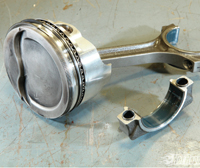Points to be considered while selection of connecting rod
Choosing a set of connecting rods for a performance engine is not as simple as it sounds. The rods you ultimately choose to use in an engine will depend on a number of factors, each of which can be critical to the life of the motor and the success of your customer.
The type of engine in which rod will be used.
The desired torque and horsepower curves the engine will produce.
The maximum rpm it will turn.
The physical dimensions of the engine itself.
The relative importance of weight, strength and reliability of a rod.
The type of rods which you choose or the style of rods that are available to fit the engine which you built (I-Beam, H-Beam, A-Beam or other variants).
The type of rod material you want, or is available to fit the engine you are building (4340 or 300M forged or billet steel, aluminum, powder metal or titanium).
Horsepower vs. RPM
When it comes to rod selection, which is more important: horsepower or rpm? Higher power levels increase the compressive force on the connecting rods while higher rpms increase the tensile strain on the rods. As it turns out, most rods don’t bend and fail on the compression stroke but are pulled apart at high rpm and break on the exhaust stroke. Consequently, rods need additional compression strength and stiffness to handle higher horsepower loads. But in hig- revving engines, increased tensile strength is an absolute must for the rods to survive at high rpm.
The two basic styles of connecting rods are I-Beam and H-Beam. Some rod suppliers only make I-Beams, others only make H-Beams, and some offer both types or variants of the I-Beam design. The I-Beam design is used for most stock connecting rods because it provides a good combination of light weight and strength.
An I-Beam rod can handle high compressive loads while also providing good tensile strength. But the thickness and strength of the steel in the rod limit what it can safely handle. So performance I-Beam rods are typically made of a higher grade of steel (4340 or 300M), and often have a thicker cross-section in critical areas to increase strength.
H-Beam rods have a completely different design. An H-Beam rod has two large, flat sides that are perpendicular to the piston pin and crankshaft journal, with a thin center section in the middle. This makes the H-Beam design very stiff so it can handle higher compressive loads without bending.
Which is stronger, I-Beams or H-Beams?
It depends whom you ask, and the relative weights and cross-sections of the rods. I-Beams can be just as strong as H-Beams, but H-Beams can often handle higher compressive loads than I-Beams with less overall weight.
Consequently, H-Beam connecting rods are often recommended for high torque motors that produce a lot of power at low rpm (under 6,000 rpm). Some rod suppliers offer H-Beams as their "entry level" or less expensive line of performance rods, and offer I-Beams for all of their high end racing applications. Other suppliers only sell I-Beams, and some only sell H-Beams.


INFORMATION ON CONNECTING RODS
- Connecting Rod for KIA PRIDE
- Connecting Rod for LAND ROVER
- Connecting Rod for MITSUBISHI
- Connecting Rod for PEUGEOT
- Connecting Rod for PEYKAN
- Connecting Rod for RENAULT
- Connecting Rod for ROMANIYA
- Connecting Rod for SCANIA
- Connecting Rod for CUMMINS
- Connecting Rod for KIRLOSKAR
- Connecting Rod for MERCEDES BENZ
- Connecting Rod for PERKINS
- Connecting Rod for TOYOTA
- Connecting Rod for FIAT
- Connecting Rod for FORD
- Connecting Rod for NISSAN
- Engine Connecting rod
- Connecting rod Works
- Connecting Rod Types
- Materials Used in Connecting rod
- Important of connecting rod in Engine
- Applications of Connecting rod
- Connecting Rod Used In
- Quality Parameters For Connecting Rod
- Selection of Connecting rod
- Why Choose Us?








